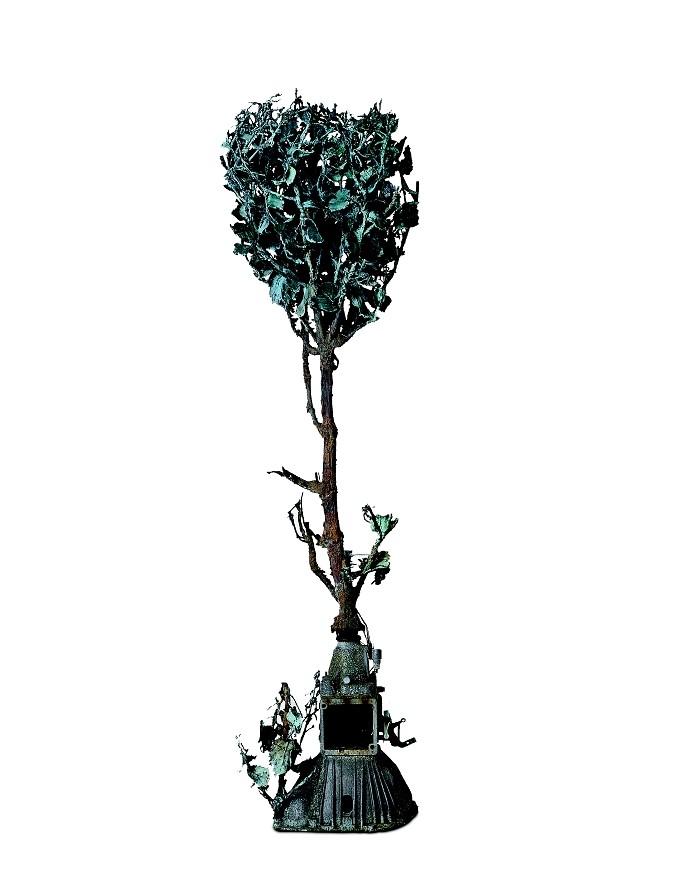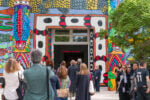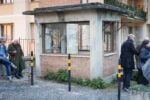Alik Cavaliere

Nell’ambito delle mostre promosse a Milano, Sotheby’s è lieta di accogliere nei propri spazi la mostra dedicata ad Alik Cavaliere (1926-1998) a cura di Angela Vettese.
Comunicato stampa
Credo di aver fatto scultura sempre per necessità espressive, comunicative, estetiche, di linguaggio (talora trasgredendo le tecniche), salvandomi, mi auguro, dal diventare un buon professionista produttore di beni artistici.
L’ARTISTA
Nell'ambito delle mostre promosse a Milano, Sotheby’s è lieta di accogliere nei propri spazi la mostra dedicata ad Alik Cavaliere (1926-1998) a cura di Angela Vettese.
Figlio del poeta Alberto Cavaliere e della scultrice ucraina Fanny Kaufmann, dopo un’infanzia condizionata dall’attività antifascista del padre e dalle leggi antisemite, compie gli studi al Liceo Berchet di Milano e si diploma all’Accademia di Brera, sotto la guida di Marino Marini, al quale succede nel 1970 alla cattedra di scultura.
Raffinato prosecutore del dadaismo e attento alla lettura di Duchamp, di cui fu assiduo frequentatore grazie ad Arturo Schwarz, e del vocabolario dada- surrealista, ha piegato il linguaggio della scultura classica all’idea di montaggio, bricolage e object trouvé che caratterizza l’arte più innovativa del Novecento, cui fanno seguito l’indagine della scultura ambientale e di un environment sempre disposto a cambiare, cioè ad assumere forme impreviste, aggiunte, aggiustamenti a seconda del contesto architettonico ma anche di relazioni umane in cui si viene a trovare. Per la sua capacità di affrontare la sfida linguistica del XX secolo, associandola con i temi costanti della vita, Cavaliere ha una ricchezza di temi che merita una vasta rilettura critica.
LA VICENDA
Negli anni Cinquanta Cavaliere inizia a trattare il tema della Metamorfosi, che rimarrà centrale in tutta la sua ricerca. Dal 1964 esplora il tema delle vegetazioni, ispirato al De Rerum Natura di Lucrezio. Partecipa più volte alla Biennale di Venezia, insieme ad altri nella mostra Scultori italiani, nel ’56 , e con una sala personale nel 1964 e nel 1972, anno in cui presenta una delle sue opere più significative: I processi delle storie inglese di W. Shakespeare, grandiosa installazione, attualmente patrimonio della Galleria d’Arte Moderna di Roma. Nel 1964 lavora alla mostra Arbres da Arturo Schwarz. Nel 1970 realizza due environment: Apollo e Dafne e A e Z aspettano l’amore. Per tutti gli anni Settanta sviluppa e prosegue il ciclo Viva la libertà. Nel 1973 presenta - nell’ambito della XII Biennale d’Arte al Museo Middelheim di Anversa - l’installazione Surroundings a cui lavorerà per oltre dieci anni. Negli anni Ottanta perpetua la modalità delle grandi installazioni, realizzando i Percorsi, “dei labirinti, scrive l’artista, in cui potermi incontrare con l’eventuale visitatore/spettatore per poi perderci entrambi all’interno dell’opera stessa”. Le sue ambientazioni, labirinti che raccontano sia la struttura della mente che quella dell’esistenza, includono La Memoria (1987), Passato, presente e… Pian Cordova, oggi al MART di Rovereto. La sua ultima grande opera, incompiuta, è il Grande Albero, oggi esposto nel chiostro del Conservatorio di Milano. Oggi buona parte del suo lavoro ruota negli spazi del Centro Artistico Alik Cavaliere, via De Amicis 17, a Milano.
LA MOSTRA
Questa piccola mostra si propone, come sineddoche di un itinerario complesso, in cui le suggestioni letterarie si legano continuamente a ricerche concettuali, ben oltre un puro rispetto della scultura tradizionale il lessico, al contrario, Cavaliere ribalta continuamente.
Due precoci sculture, Studio per giochi proibiti (1958/1959) e Fine di un amore (1962) sono scortate dai dipinti che ne hanno accompagnato la creazione, vere pitture da scultore gravide della terza dimensione. Gli Arbres premettono di ritrovare il sapore della sala personale che l’artista ebbe alla Biennale di Venezia del 1964. Troviamo ironia e ricerca sui materiali in E ne ha così assoluta certezza, quanta se n’abbia l’istessa natura (1966-1967) e nel Cortile (1965-67), dove la materia plastica avvolge e separa le parti in bronzo e dove omini malcapitati, costretti all’anonimato della metropoli, hanno i piedi al posto della testa. Nell’opera …e venne la pioggia (1968) l’acqua restituisce suono e movimento, con sincronismo rispetto alle ricerche cinetiche, polimateriche e ambientali di quegli anni. Albero-cambio (1987) racconta la complessità della correlazione tra l’uomo e la natura – oggi diremmo tra corpo organico e cyborg - che Cavaliere associa la vegetazione a un corpo meccanico come un continuum bizzarro di funzioni. L’opera più recente, Dafne, 1991, riassume il continuo confronto di Cavaliere con il mito e la storia delle sue rappresentazioni. Il mito ci racconta chi siamo e ci accompagna nei secoli: Dafne che fugge Apollo diventando parte della natura è un esempio di come favole antiche interpretino ancora oggi le nostre paure, le nostre aspirazioni e tutto ciò che ci muove dal profondo.
LE OPERE
1958-1959, Studio per giochi proibiti: bronzo, cm 70x26x43
1962, Fine di un amore: porcellana, bronzo, 38x90x63 cm.
1965-1967, Il cortile: bronzo, resina, legno, ceramica, porcellana, piombo, 81x82x66 cm.
1966-1967, ...E ne ha così assoluta certezza, quanto se n’abbia l’istessa natura: bronzo, acciaio, plastica 261x137x95 cm.
1968, ...E venne la pioggia: bronzo, acciaio, alluminio, cristallo, sassi, acqua, 150x100x70
1987, Albero cambio: bronzo, alluminio, acciaio 206x73x57 cm.
1991, Dafne: bronzo, ottone, 171x66x50 cm.
ALIK CAVALIERE
Sotheby’s Milano Palazzo Serbelloni, Corso Venezia 16
Lunedi 4 Aprile ore 18.00
Conversazione con Angela Vettese e Fania Cavaliere
A seguire
Esposizione
Martedì 5 – Giovedì 7 Aprile ore 10-18
Venerdì 8 Aprile ore 10-13
For More News From Sotheby’s
Visit: www.sothebys.com/en/inside/services/press/news/news.html
Follow: www.twitter.com/sothebys
Join: www.facebook.com/sothebys & www.weibo.com/sothebyshongkong
Watch: www.youtube.com/sothebys
Sotheby’s has been uniting collectors with world-class works of art since 1744. Sotheby’s became the first international auction house when it expanded from London to New York (1955), the first to conduct sales in Hong Kong (1973) and France (2001), and the first international fine art auction house in China (2012). Today, Sotheby’s presents auctions in 8 different salesrooms, including New York, London, Hong Kong and Paris, and Sotheby’s BidNow program allows visitors to view all auctions live online and place bids in real-time from anywhere in the world. Sotheby’s offers collectors the resources of Sotheby’s Financial Services, the world’s only full-service art financing company, as well as private sale opportunities in more than 70 categories, including S|2, the gallery arm of Sotheby's Contemporary Art department, as well as Sotheby’s Diamonds and Sotheby’s Wine. Sotheby’s has a global network of 90 offices in 40 countries and is the oldest company listed on the New York Stock Exchange (BID).
*Estimates do not include buyer’s premium and prices achieved include the hammer price plus buyer’s premium.
I think that expressivity, communication, esthetic and language are the necessity that made me a sculptor, and that save me to become a professional manufacturer of artistic goods.
THE ARTIST
Sotheby’s is pleased to host the exhibition Alik Cavaliere (1926-1998) curated by Angela Vettese.
Son of the poet Alberto Cavaliere and the ukraine sculptress Fanny Kaufmann, his childhood was influenced by his father’s antifascist political affiliation and by anti-Semitic laws that characterized those times. He studied at Berchet high school of Milan and he graduated at Brera Academy, under the supervision of Marino Marini, to whom he succeeded as professor of sculpture in 1970.
At first, Cavaliere followed the Dadaism movement and was interested in Duchamp’s literature, with whom he engaged a long-term intellectual partnership thanks to Arturo Schwarz. Moved by a dada-surrealist perspective, he adapted classical sculpturing language to the new forms of vocabulary as bricolage and object trouvè. Following this path, he began investigating on environmental sculpturing, fascinated by an ever-changing world, where unexpected forms adapt themselves to architecture and social behavior. Hence, his rich linguistic knowledge and his constant exploration of the issues of life are worth being studied in greater depth.
STORY
In the 1950s Cavaliere began his study on the theme of Metamorfosi, which will remain one of his central topics of research. From 1964 he explores the subject of vegetation, inspired by Lucrezio’s De Rerum Natur. He participates several times in the Biennale of Venice: firstly in 1956 as part of a group “Scultori Italiani”, and later on, both in 1964 and 1972, with a solo exhibition where he presented some of his most significant works: I processi delle storie inglese di W. Shakespeare, today inherited by the Galleria d’Arte Moderna of Rome. In 1964 he works at the exhibition Arbres at Arturo Schwarz. In 1970 he creates two environment: Apollo e Dafne and A e Z aspettano l’amore. During the seventies he developed and continued working on the cycle Viva la libertà. In 1973 he presented the installation Surroundings at the XII Biennale of Art at the museum Middelheim in Antwerp, a piece on which he worked on for more than ten years.
In the eighties he creates Percorsi, a set of large installations he describes as: “..labyrinths where i could meet the viewer and lose myself with him in the work”. These sceneries are labyrinths that tell both the structure of the mind and that one of our existence, and they include La Memoria (1987), Passato, presente e… Pian Cordov.
His last large piece, which remained incomplete, is Grande Albero, which is exhibited today at the Conservatory of Milan. Much of his work can be appreciated in the halls of the Centro Artistico Alik Cavaliere, in Via De Amicis 17, Milan.
EXHIBITION
Sotheby’s exhibition proposes a complex itinerary that continuously links literary references to conceptual research.
Studio per giochi proibiti (1958/1959) and Fine di un amore (1962) are two sculptures accompanied by the paintings that led to their creation and that are characterized by an intense study of the third dimension. Arbres ?? allow the audience to have a taste of the artist’s solo exhibition at the Biennale of Venice in 1964.
…E ne ha così assoluta certezza, quanta se n’abbia l’istessa natura (1966-1967) and Cortile (1965-67) display silent men, reduced to the anonymity by the metropolis, with their feet instead of their head. Material research is not left apart, and the plastic surrounds and separates the parts in bronze.
In the work…e venne la pioggia (1968), it is water that creates sounds and movement, in correlation with researches of that period on kinetic energy, materials and the environment.
Albero-cambio (1987) describes the complexity of the correlation between man and nature – today we would say between man and cyborg - where Cavaliere associates vegetation to a mechanical body.
The most recent work, Dafne (1991) summarizes Cavaliere’s continuous comparison between myth and history. Myths tell us who we are and walk with us hand in hand through the centuries, for instance, Dafne who escapes from Apollo by becoming part of nature is an example of how ancient myths still interpret today our fears, aspirations and all that moves us from the within.
LE OPERE
1958-1959, Studio per giochi proibiti: bronzo, cm 70x26x43
1962, Fine di un amore: porcelain, bronze, 38x90x63 cm.
1965-1967, Il cortile: bronze, resin, wood, ceramic, porcelain, lead, 81x82x66 cm.
1966-1967, ...E ne ha così assoluta certezza, quanto se n’abbia l’istessa natura: bronze, steel, plastic 261x137x95 cm.
1968, ...E venne la pioggia: bronze, steel, aliminium,glass, stones, water 150x100x70
1987, Albero cambio: bronze, steel, aluminum 206x73x57 cm.
1991, Dafne: bronze, brass 171x66x50 cm.
ALIK CAVALIERE
Sotheby’s Milano Palazzo Serbelloni, Corso Venezia 16
Monday 4 April 18.00
Conversation with Angela Vettese and Fania Cavaliere
Exhibition
Tuesday 5 – Thursday 7 April 10-18
Friday 8 April 10-13
For More News From Sotheby’s
Visit: www.sothebys.com/en/inside/services/press/news/news.html
Follow: www.twitter.com/sothebys
Join: www.facebook.com/sothebys & www.weibo.com/sothebyshongkong
Watch: www.youtube.com/sothebys
Sotheby’s has been uniting collectors with world-class works of art since 1744. Sotheby’s became the first international auction house when it expanded from London to New York (1955), the first to conduct sales in Hong Kong (1973) and France (2001), and the first international fine art auction house in China (2012). Today, Sotheby’s presents auctions in 8 different salesrooms, including New York, London, Hong Kong and Paris, and Sotheby’s BidNow program allows visitors to view all auctions live online and place bids in real-time from anywhere in the world. Sotheby’s offers collectors the resources of Sotheby’s Financial Services, the world’s only full-service art financing company, as well as private sale opportunities in more than 70 categories, including S|2, the gallery arm of Sotheby's Contemporary Art department, as well as Sotheby’s Diamonds and Sotheby’s Wine. Sotheby’s has a global network of 90 offices in 40 countries and is the oldest company listed on the New York Stock Exchange (BID).
*Estimates do not include buyer’s premium and prices achieved include the hammer price plus buyer’s premium.



